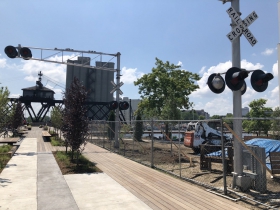Should City Buy Third Ward Swing Bridge?
Ald. Robert Bauman advances idea to turn swing bridge into pedestrian bridge.
A new link is in the works between the Historic Third Ward and Walker’s Point. To make the connection happen and further extend the Milwaukee RiverWalk, a long-unused railroad swing bridge in the Milwaukee River would be repurposed as the central link in a new pedestrian bridge.
Alderman Robert Bauman introduced the idea of the city acquiring the bridge at a ribbon cutting ceremony Thursday afternoon for Trestle Park. The new third-of-an-acre park at 501 E. Erie St,, designed by Jim Shields of HGA, is already a hit, drawing a steady stream of visitors onto the former railroad trestle that has been artfully repurposed.
The Mandel Group, which hosted Thursday’s event, had released conceptual site plans in July of a pedestrian bridge going through the swing bridge. The company is planning a $130-million, mixed-use development on the south side of the river. A tax incremental financing (TIF) district that harvested incremental property tax revenue from Mandel’s new development could be used to fund the bridge, similar to how the E. Erie St. riverwalk TIF district funded the $1 million Trestle Park.
Bauman suggested the bridge’s current owner, Union Pacific, may be interested in donating a sum equivalent to the cost of removing the bridge to the city’s effort. “I think we need to work out a deal with Union Pacific so it doesn’t get demolished or scrapped.”
Cyclists going between the lakefront trail network and the South Side must now continue on E. Erie St. to the Broadway bridge, then backtrack on S. Water St. before heading south towards the Kinnickinnic River Trail‘s northern segment that parallels the Canadian Pacific railroad tracks. A swing bridge link would shave a half mile off the trip and eliminate a series of awkward intersections where cars and cyclists mix.
A new bridge has a number of obstacles, both political and physical. The city must first acquire the bridge from the railroad, and then contend with Coast Guard regulations that govern immobile objects in navigable waters. From a logistical standpoint, any new bridge must either lift or retract to accommodate the extensive amount of boat traffic that currently goes around the bridge. Mandel envisions only one of two bridge spans would be operable.
“A first‐hand experience I enjoyed in Copenhagen earlier this year convinced me of the feasibility of using a movable bridge span to protect navigation through this area. It would provide a way to join these neighborhoods together. More importantly, it would leverage the existing metro‐wide bikeways that criss‐cross at this point, having a regional impact on bike trail systems both north/south and east/west,” said Mandel Group Chief Operating Office Robert Monnat in a statement announcing the company’s vision.
A cost estimate for the new bridge is not available.
The bridge was built in 1915 by the Chicago & North Western Railway and long served as a critical piece of infrastructure on the company’s mainline between Chicago and St. Paul. Over 100 trains a day would roar over the bridge, known as Drawbridge #1556 in company documents, as they went north into the long-gone Lakefront Depot or south towards Chicago. The passenger trains of the era were in a hurry, as they had to live up to their name: the 400, which reflected the number of minutes it took to go between Chicago and St. Paul.
The bridge has been owned by Union Pacific since the railroad giant acquired CNW in 1995. According to a 2006 city historic designation report, the bridge weighs 800 tons and is 32-feet wide and 243-feet long.
The railroad is certain not to use it as a train bridge anytime soon, assuming that it would still turn. Tracks on the north side have been removed for Trestle Park, which still maintains much of the signaling as a nod to the park’s origin. The south side is in better shape, with a track network winding through the Harbor District, but there are no rails at the immediate bridge landing.
The idea of the swing bridge as a pedestrian bridge isn’t new. La Dallman Architects has won multiple national design awards for a plan to repurpose the swing bridge as a park in the middle of a new pedestrian bridge.
Mandel Group Plans
Trestle Park
A large crowd attended the ribbon cutting ceremony for the new park. The park is formed by the combination of a pocket park along E. Erie St. and a 150-foot-long by 40-foot-wide trestle. A new riverwalk segment connects to existing segments on each side and completes the 1.1-mile-long Historic Third Ward portion of the more-than-three-miles-long system.
Mayor Tom Barrett was on hand to welcome everyone to the new park and praised Mandel’s vision for development in the city and how it all connects together. “People in isolation doesn’t constitute a city,” said Barrett. “What constitutes a city is people in circulation.”
Guests were treated to beer by Lakefront Brewery, which is located at the other end of the riverwalk network, as well as food from DanDan, Batches and Cermak Fresh Market.
The $1.2 million park was funded by a tax-incremental financing district that covers E. Erie St. from the Broadway Bridge to the Erie Street Plaza. Included in that district are three condominium projects — the Marine Terminal Lofts, Hansen’s Landing and Harbor Front buildings — that are generating $3.8 million in annual incremental revenue to pay off the district debt. Much of the cost of the park went into re-decking the trestle structure according to Department of City Development staffer Alyssa Remington.
The new park includes a relocated Bublr Bikes station. The dock was relocated from a sleepy stretch of N. Jefferson St. a few blocks to the north.
Construction of the park was led by CD Smith through a unique partnership with the city. CD Smith built the park as part of the firm’s construction of Mandel’s DoMUS apartments.
The Historic Third Ward Business Improvement District will manage and maintain the park.
Urban Milwaukee last covered the park in early July.
Ribbon Cutting Photos
Park Photos
If you think stories like this are important, become a member of Urban Milwaukee and help support real independent journalism. Plus you get some cool added benefits, all detailed here.
Political Contributions Tracker
Displaying political contributions between people mentioned in this story. Learn more.
- December 17, 2020 - Tom Barrett received $1,000 from Robert Monnat
- November 27, 2018 - Tom Barrett received $100 from Robert Monnat
- September 11, 2014 - Robert Bauman received $250 from Robert Monnat
Eyes on Milwaukee
-
Church, Cupid Partner On Affordable Housing
 Dec 4th, 2023 by Jeramey Jannene
Dec 4th, 2023 by Jeramey Jannene
-
Downtown Building Sells For Nearly Twice Its Assessed Value
 Nov 12th, 2023 by Jeramey Jannene
Nov 12th, 2023 by Jeramey Jannene
-
Immigration Office Moving To 310W Building
 Oct 25th, 2023 by Jeramey Jannene
Oct 25th, 2023 by Jeramey Jannene
Transportation
-
MCTS Adds 28 New Buses
 Jul 13th, 2024 by Graham Kilmer
Jul 13th, 2024 by Graham Kilmer
-
MCTS Designing New Bus Shelters
 Jul 10th, 2024 by Graham Kilmer
Jul 10th, 2024 by Graham Kilmer
-
MCTS Updates RNC Bus Detours To Better Serve Downtown, Riders
 Jul 9th, 2024 by Jeramey Jannene
Jul 9th, 2024 by Jeramey Jannene







































I’m assuming this park fell apart when Mandel dropped their plans south of the river? This would still be really cool, and better connect Walker’s Point to the Third Ward.
The City cannot afford what it already has. So it is going to buy new things? Work on paying for what we already have first.
Great idea, if it can be pulled off!
The 3rd Ward and now the 5th Ward, increasingly, pay a ton of property taxes, plus subsidize several of the city’s TIFs. All due to growth. This would be an investment in the high growth part of town. It would so much more than pay for itself. I wish the city would give visibility to where the revenue comes from, because until and unless the state helps, this is our only hope at increasing the city coffers.
The swing bridge in Trestle Park marks the dividing line between Lake Michigan and the Milwaukee River, according to the Wisconsin DNR… When you fish downstream from the bridge, you’re fishing on Lake Michigan… When you fish upstream from the bridge, you’re fishing on the Milwaukee River… The same rule applies to the swing bridge on the Kinnickinnic River.